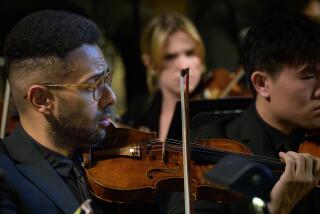Beating the ‘Drumpet’ for Hands-On Music Education
Craig Woodson dangled a stick with a string attached in front of 120 kids sitting cross-legged at UCLA’s Royce Hall.
“What is this?” he asked.
“Fishing pole!” the second- and third-graders from Carson Street Elementary yelled. They had gathered on campus for a day of hands-on learning as part of Design for Sharing, a support program of UCLA Live, which has been introducing audiences -- from kindergartners to the elderly -- to music, theater and dance for 35 years.
During this session, the antsy children were soon enraptured by Woodson’s jokes and silly antics.
The ethnomusicologist, who studies music in its social and cultural context and who teaches at Kent State and Xavier universities, demonstrated how cultures have developed musical traditions by experimenting with and transforming everyday items.
Woodson tied the string to the other end of the stick, making a bow. He pulled out a chopstick.
“Shoot something!” one boy shouted as others giggled.
Instead, the 60-year-old rubbed the chopstick across the string, plucking out a tune. He amplified the sound by sliding a polystyrene cup on the top.
Woodson then displayed other instruments he had made: a trumpet fashioned from a garden hose and funnel, and a drum made from a square wooden frame and tightly wound clear tape and another funnel.
“In Africa, kids your age make instruments like these,” Woodson said. His lesson is part of the UCLA organization’s My Different World program, which buses second- and third-graders from the Los Angeles area to the campus to learn about the performing arts. About 25,000 students from more than 100 schools participate each year.
Before lunch, the children each got a white paper bag filled with a cardboard tube, colored Band-Aid tape, a crayon, a Slurpee-style plastic dome lid, a cardboard mini-canister with a plastic cap, a piece of elastic gold string, a prong fastener and a rubber band. Their instructions were to make a “drumpet,” a cross between a drum and trumpet.
They wrapped one end of their tubes with the tape and jammed the plastic lid onto the other end. Next, the children used their prong fasteners to pierce the lids of the mini-canisters. The elastic strings were threaded through the holes to hang out of the metal-bottomed canister drums, which were then taped to the tubes.
Woodson started making these instruments in 1980 after traveling in Africa, where he saw children making and enjoying instruments by using everyday items from their villages. He had gone to Ghana to build instruments for developing school music programs.
“I realized that making instruments was a really important part of owning the music,” Woodson said. “All of these instruments are just a matter of experimentation, and you try it and sometimes it’s a yes and sometimes it’s blah.”
As the children put the finishing touches on their drumpets, Woodson called attention back to himself with a yell.
“Everybody, Bill Cosby smiles -- no teeth,” Woodson called out. “Make kissy lips now on the Band-Aid end, 1-2-3.”
Cheeks puffed out and raucous trumpeting blared.
“It feels exciting,” 8-year-old Maria Rodriguez said of making and playing her own instrument. “I wish I could never go [back] to school. I wish I could stay here.”
According to co-founder Mimi Perloff, Design for Sharing has inspired those thoughts in thousands since its start in 1969.
“They’re so thirsty,” Perloff said, “they are so hungry for this type of thing.”
As a 700-member nonprofit organization, Design for Sharing funds its endeavors through dues and donations. In addition to classes such as Woodson’s, Design for Sharing buys and distributes tickets for concerts and theater performances to local organizations such as AIDS Project Los Angeles, the Culver City Senior Center and Venice Community Housing Corp.
Before classes arrive for performance-demonstrations such as the one those from Carson Street Elementary attended, teachers receive packets full of ideas on how to incorporate the arts into daily lessons.
Said Pattikay Gottlieb, a Design for Sharing board member: “We try to make this more than just a one-time field trip.”
More to Read
The biggest entertainment stories
Get our big stories about Hollywood, film, television, music, arts, culture and more right in your inbox as soon as they publish.
You may occasionally receive promotional content from the Los Angeles Times.










